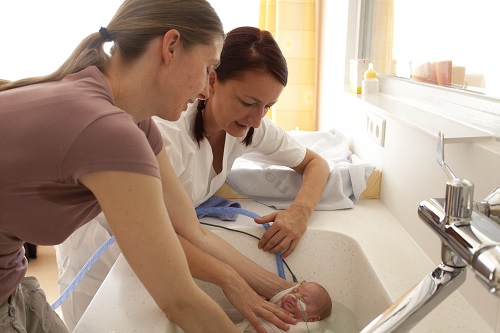Authors
Hankes Drielsma I, Oude-Reimer M, Frauenfelder O, Camba F, Ceccatelli M, Kalbér A, Kühn T, Silva E

Infants, parents, and families
Healthcare professionals, neonatal units, hospitals, and health services
All infants receive appropriate activities of daily living (ADL), commencing with low-stress cleaning and moving to methods that support self-regulation once the infant is stable, alert and interactive.
Activities of daily living (ADL) are described as tasks that every human being participates in for personal care such as eating, bathing, dressing, toileting and repositioning themselves. All infants depend on others (parents) for these daily activities in which they experience trust, empathy and bonding. (1,2)
All caregivers have to be aware that infants’ skin is particularly sensitive (3) and cleaning can negatively affect skin integrity (4,5); therefore, early and frequent washing and bathing should be avoided. Furthermore, these procedures can lead to distress and physiological, as well as thermal, instability. (6–8)
Choosing an appropriate ADL includes a washing method that leads to the least distress and disruption of sleep in the infant. (7,9,10)
There are different washing methods like cleaning the minimum of body parts, sponge bathing, or immersion bathing. Washing an infant should never be a scheduled task but should always be cue based and individualised. (3,4,6,9,11–13)
The bio-behavioural cues of the infant should be the leading factor to decide the correct washing method.
For parents and family
A (High quality)
B (High quality)
Patient information sheet1
A (High quality)
B (High quality)
Clinical records, parent feedback, patient information sheet1
A (High quality)
B (High quality)
Guideline, patient information sheet1
B (Moderate quality)
Training documentation
For healthcare professionals
A (High quality)
B (High quality)
Guideline
B (High quality)
Training documentation
A (High quality)
B (High quality)
Guideline
For neonatal unit
A (High quality)
B (High quality)
Guideline
A (High quality)
B (High quality)
Training documentation
For hospital
B (High quality)
Training documentation
B (Moderate quality)
Guideline
For health service
N/A
1The indicator “patient information sheet” is an example for written, detailed information, in which digital solutions are included, such as web-based systems, apps, brochures, information leaflets, and booklets.
For parents and family
N/A
For healthcare professionals
N/A
For neonatal unit
N/A
For hospital
N/A
For health service
N/A
For parents and family
For healthcare professionals
For neonatal unit
For hospital
For health service
N/A
Coughlin (9) describes how age-appropriate activities of daily living (ADL’s) in the NICU include postural support, feeding and skin management. She underlines the importance for healthcare professionals to partner with parents in the provision of ADL’s. This partnership not only creates parental confidence and competence but also validates the parental role while meeting the fundamental age appropriate needs of their infant. (18)
All infants, and especially ill and preterm infants, are exposed to many stressors due to medical and nursing care procedures needed to support physiological needs that are often painful. (3,5,9,18) Other stressors infants in the NICU are exposed to are interrupted sleep, excessive noise and light levels and daily care procedures in an unfamiliar extra-uterine environment without the protection of their mother. (6)
When deciding the appropriate washing method for an individual infant it’s not only important to take the age of the infant into consideration but more so to observe the infant’s cues through different subsystems. These include autonomic integrity, motor activity the infant state, attention capacity and self regulation based on the Synactive Theory of Development. (1,2) Bathing should be delayed until an infant shows competence across the five subsystems.
After birth infants should not be washed. Inspection of the scalp is indicated if the newborn infant was invasively monitored during labour to identify skin damage and prevent infections. When the hair of a newborn infant is full of blood or green amniotic fluid the hair and body may be gently washed. There are no other reasons to give a full term infant a bath after birth.
Very preterm infants in the NICU who show signs of instability should never be bathed or sponge bathed fully in order to avoid distress. (11) Places where the skin can become irritated and may require cleansing are face (eyes), behind the ears, neck/throat, armpits, hands between the fingers and feet between toes. This can be carried out with warm sterile water or breast milk. (see Care procedures) Cleansing a body part should be done gently while responding to the newborn infant’s cues and letting parents support their newborn infant. A “4-hands-manoever” is recommended for such possible stress related procedures”: two carers, ideally one healthcare professional and one parent perform body cleansing procedures: one providing care, the other supporting the infant to remain stable and calm in a potential stressful situation.
Once the infant is in a step down unit or in the NICU shows competence across the 5 subsystems the infant may be ready to experience being bathed while swaddled. (6,7,11,13) Swaddled bathing helps the infants feel secure and gives them support to self-regulate. This way they can be an active participant. Every healthcare professional should see bathing as a social event that promotes the wellbeing of the infant and includes the parents. Parental participation helps them feel confident and competent. During this process healthcare professionals can support the parents by helping them to move slowly, watch, interpret and respond to their infant’s cues. A calmed bathing experience is an ideal situation to bring parents and their child into interaction, communicating to each other. This will increase self-confidence and resilience of the parents and is a perfect tool to establish secure parent-child bonding.
November 2018 / 1st edition / next revision: 2023
Recommended citation
EFCNI, Hankes Drielsma I, Oude-Reimer M et al., European Standards of Care for Newborn Health: Supporting the infant during hygiene procedures. 2018.